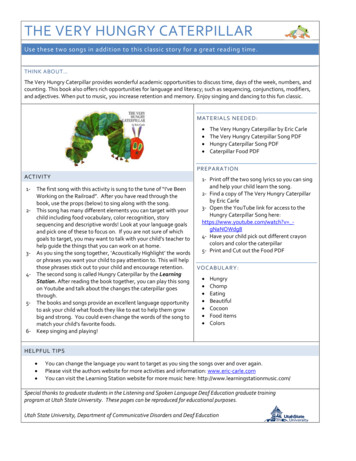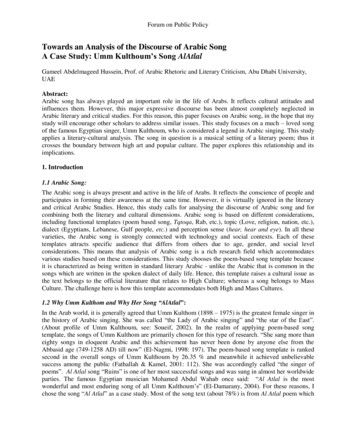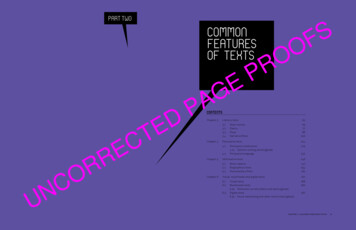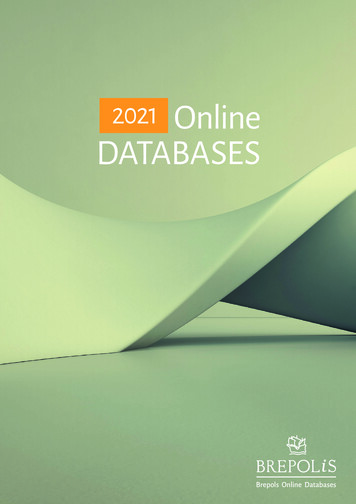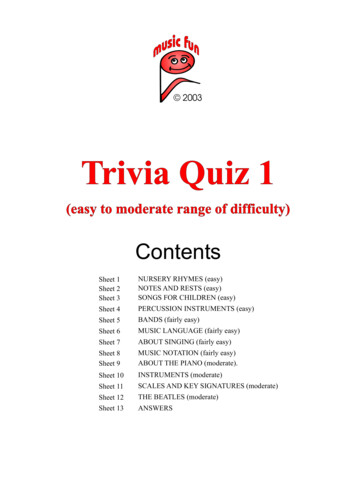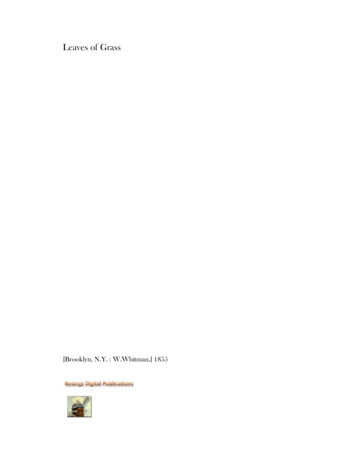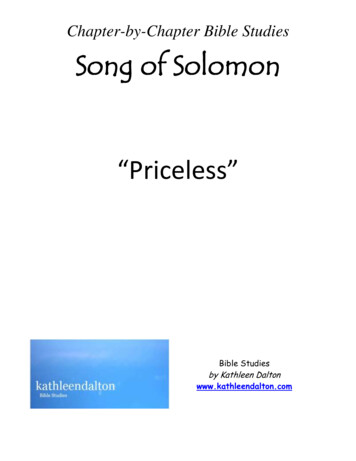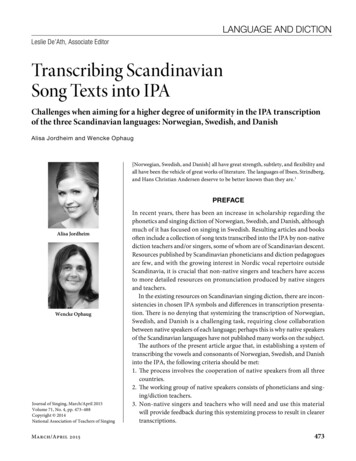
Transcription
LANGUAGE AND DICTIONLeslie De’Ath, Associate EditorTranscribing ScandinavianSong Texts into IPAChallenges when aiming for a higher degree of uniformity in the IPA transcriptionof the three Scandinavian languages: Norwegian, Swedish, and DanishAlisa Jordheim and Wencke Ophaug[Norwegian, Swedish, and Danish] all have great strength, subtlety, and flexibility andall have been the vehicle of great works of literature. The languages of Ibsen, Strindberg,and Hans Christian Andersen deserve to be better known than they are.1PREFACEAlisa JordheimWencke OphaugJournal of Singing, March/April 2015Volume 71, No. 4, pp. 473–488Copyright 2014National Association of Teachers of SingingMarch/April 2015In recent years, there has been an increase in scholarship regarding thephonetics and singing diction of Norwegian, Swedish, and Danish, althoughmuch of it has focused on singing in Swedish. Resulting articles and booksoften include a collection of song texts transcribed into the IPA by non-nativediction teachers and/or singers, some of whom are of Scandinavian descent.Resources published by Scandinavian phoneticians and diction pedagoguesare few, and with the growing interest in Nordic vocal repertoire outsideScandinavia, it is crucial that non-native singers and teachers have accessto more detailed resources on pronunciation produced by native singersand teachers.In the existing resources on Scandinavian singing diction, there are inconsistencies in chosen IPA symbols and differences in transcription presentation. There is no denying that systemizing the transcription of Norwegian,Swedish, and Danish is a challenging task, requiring close collaborationbetween native speakers of each language; perhaps this is why native speakersof the Scandinavian languages have not published many works on the subject.The authors of the present article argue that, in establishing a system oftranscribing the vowels and consonants of Norwegian, Swedish, and Danishinto the IPA, the following criteria should be met:1. The process involves the cooperation of native speakers from all threecountries.2. The working group of native speakers consists of phoneticians and singing/diction teachers.3. Non-native singers and teachers who will need and use this materialwill provide feedback during this systemizing process to result in clearertranscriptions.473
Alisa Jordheim and Wencke Ophaug4. Established and familiar transcription traditions formthe foundation of this work, and since these languagesare Germanic in nature, the standard IPA transcription practices for German seem ideal.Since there is currently no apparent way to presentsounds within and across the boundaries of these threelanguages, decisions regarding transcription mustinclude consideration of the following: simplificationof the system for application to singing as opposed tospeech, accuracy, phonetic/phonological features, singing techniques, and transcription traditions.INTRODUCTIONNorwegian, Swedish, and Danish are historically relatedto Old Norse and are Germanic in nature; therefore,these Scandinavian languages share many structuraland grammatical characteristics. Despite inherent (andapparent) similarities when written, however, these threeScandinavian languages differ significantly in regardto pronunciation. World languages such as French,German, Italian, and English (British and American)have a long tradition of a standardized pronunciationthat has been described in phonetics books and transcribed into the International Phonetic Alphabet (IPA).To a large degree the pronunciation of these languagesin classical singing has been presented in diction booksfor singers with transcriptions of a selection of songtexts. Singers unfamiliar with many foreign languagesmay profit immensely from these transcriptions, assuming they know how to read and interpret IPA. Englishspeakers do not learn to speak many foreign languages,and this likely is the reason that teaching and learningIPA is so widespread in the preparation of singers inEnglish-speaking countries. Unlike Italian, French,German, or English, the three Scandinavian languagesdo not possess a fully standardized system of transcribing words into IPA for singing.There has been some work published in recent yearson Swedish and Finnish singing diction. However, itis important to note that Finnish is technically not aScandinavian language as it belongs to the Finno-Ugricfamily of languages. Articles on Norwegian and Danishsinging diction are appearing more frequently, and publications on Scandinavian language and diction are valuable contributions to the classical singing community.474In recent scholarship, however, unequal attentionhas been paid to the three Scandinavian languages, withthe majority of Scandinavian diction sources focusing on Swedish. Still, many developments regardingSwedish IPA transcriptions and possible pronunciation variants remain under consideration. Likewise,while some songs texts of Grieg and other NorwegianRomantic composers have been transcribed into theIPA, much regarding pronunciation of these texts hasyet to be explained, challenged, and developed, especially given that Norwegian includes three branches,Bokmål, Danish-Norwegian, and Nynorsk. Danish, byfar, is the most underrepresented of these three languages, both in scholarship and in IPA transcriptionguides for singers.The present authors recognize the need to systemize and simplify the practice of transcribing thethree Scandinavian languages while maintaining thedistinctive qualities and fine points of each. We usethe standard IPA transcription practices for Germanas a foundation for our transcriptions, because mostsingers are familiar with German diction rules and, asmentioned previously, these languages are Germanicin nature. It is important to acknowledge that nativespeakers and singers of a given language are theultimate authorities in making decisions regardingan IPA transcription system for their own language,and singers who do not speak these languages shouldconsult native diction pedagogues, phoneticians, andsingers for guidance. Furthermore, it is useful for diction pedagogues and phoneticians to cooperate whenapproaching a task such as IPA transcription, as bothbring special and specific knowledge to the table. InDenmark, two experts are now working together tofind transcription solutions for singing in Danish—alanguage with unique pronunciation and transcriptionchallenges—one is a native singing pedagogue and theother a native phonetician.2 The two authors of thisarticle are experts in different fields: Ophaug is a nativeNorwegian and a phonetician who has specialized in thephonetics of singing; Jordheim is an American singer ofNorwegian and Danish descent with a special interest inthe phonetics and singing diction of the Scandinavianlanguages. A foreign singer, she also represents thethird criterion specified in the Preface. We are in closecontact with the aforementioned Danish experts andJournal of Singing
Language and Dictionhave also consulted Swedish singers and pedagogues,including Håkan Hagegård.3The aim of the present article is to explore commonalities among the three Scandinavian languagesand to discuss transcription and pronunciation challenges and solutions. Studying the close relationshipsbetween Norwegian, Swedish, and Danish can bringabout a more comprehensive understanding of eachof these languages. Before exploring the specific challenges encountered when transcribing these languagesinto the IPA, it is necessary to provide brief historicalbackground on the development of these three languagesfrom their roots in Old Norse.Like English, German, and Dutch, the roots of theScandinavian languages can be traced back to the nowextinct Primitive (or Proto-) Germanic language.8 Walsheexplains the gradual differentiation of the Scandinavianlanguages.HISTORICAL BACKGROUNDWhile Norwegian, Swedish, and Danish still sharecertain sounds at present, over time each languagedeveloped distinctive linguistic and phonemic elements.These elements, especially the phonemic, are of paramount importance to us in our mission to systematically transcribe these languages phonetically in a clear,concise, and practical manner.The close historical relationships between Norway,Sweden, and Denmark, and their resulting influenceson one another, cannot be ignored. As Ellingboeexplains, both Norway and Sweden were under Danishrule for a brief time soon after the great plagues of the14th century; however, while Sweden became quicklyindependent from this union, Norway continued tobe under Danish rule for approximately 450 years.4Therefore, Norway’s official and literary languageduring this time was Danish, but dialects that developed from Old Norse were still spoken in rural areas.Norway declared independence from Denmark onMay 17, 1814, but due to Sweden’s strength andDenmark’s relative weakness in the Napoleonic wars,the Swedish king was given rule over Norway.5 Norwaybroke free from Swedish rule in 1905 and has beenindependent ever since. Norway’s new-found independence resulted in an impassioned sense of nationalism and the desire to establish a national language,something the country had never before possessed.6Even today, because of Norway’s long and arduousjourney to independence, Norwegian as a standardlanguage is very different from standard Swedishand Danish in that there are two national languagesin Norway. One of these is Bokmål, the official andformal literary language of Norway. While related toDanish in its written form, Bokmål is related moreclosely to Swedish in its pronunciation. The secondnational language of Norway is Landsmål, also knownas Nynorsk, and is based on dialects.7March/April 2015After the end of the Viking period the comparative unity of OldNorse gradually disintegrated. Slowly but surely the separatelanguages of Icelandic, Norwegian, Danish, and Swedish beganto go their separate ways. Even the interrelations betweenNorwegian, Swedish, and Danish underwent a change . . . Thecomparative isolation of Danish as opposed to Norwegian andSwedish was doubtless most apparent in the pronunciation.Danish lost its musical accent and presumably by this time [after1370] began to develop the characteristic stød, or glottal stop . . .9HOW AND WHAT TO TRANSCRIBEBecause these languages share Germanic roots, andEnglish-speaking singers generally are familiar with theGerman IPA system and German singing diction, thefoundation of our selection of IPA symbols for the translation of Scandinavian language texts is the German IPAtradition. However, because the “placement” of sounds(especially vowels, but also consonants) varies acrossthese languages, indicating placement by employingdiacritics poses an important question: How many symbols and corresponding diacritics are really necessary inorder to produce an accurate, readable, and approachable IPA transcription? De’Ath states that “the amountof allophonic detail applied to a phonetic transcriptionshould, if anything, be greater for a non-native speakerthan for one who is fluent, regardless of the language ofthe text.”10 However, he also points out that an overlydetailed phonetic transcription “looks cumbersome”and may overwhelm the reader with “informationfatigue syndrome.” In order to decide upon appropriateIPA symbols and inclusion of diacritics, a study of thephonemes and corresponding allophonic variations ofthese three languages is essential.475
Alisa Jordheim and Wencke Ophaug“Norwegianizing” Danish Texts andConsequent ControversyAs mentioned earlier, Norway’s official and literarylanguage was Danish during the years that Norway wasruled by Denmark. After Norway became independent,the language developed into a sort of hybrid: DanishNorwegian, which applies a Norwegian pronunciation to Danish words. Thus, many of the songs fromthe Romantic period have purely Danish or DanishNorwegian texts and are set by Norwegian composers(the songs of Alnæs and Grieg are prime examples). Thisposes a challenge for the singer, and possible solutionsdepend on whether the singer and the majority of his orher audience are Danish, Norwegian, or from neithercountry. For instance, it is possible to have a Danishtext (e.g., Ludvig-Holstein) set by a Danish composer(e.g., Carl Nielsen); a Danish text (e.g., H. C. Andersen)set by a Norwegian composer (e.g., Edvard Grieg); ora Danish-Norwegian text (by a Norwegian poet, likeTheodor Caspari) set by a Norwegian composer (e.g.,Eyvind Alnæs). What would a Norwegian singer doin each of these situations in terms of pronunciation?What about a Danish singer? Lastly, what would asinger from neither country—someone with little experience in either language—do? To gain more insightinto this issue, we sent a questionnaire electronicallyto Norwegian and Danish singers, as well as to singerswho are neither Norwegian nor Danish, to solicit theirviews on pronunciation in each of these situations. Foreach of the situations described above, recipients wereinstructed to provide one of four answers: 1) Danishpronunciation; 2) “Norwegianize” the pronunciation(meaning to change some of the Danish words to thoseof the same meaning in Norwegian, and/or to changethe pronunciation from Danish to Norwegian); 3)depends on the audience; 4) not sure. While the resultsvaried slightly, the majority of the recipients concurredin their choice of solution for each situation. In the firstcase (Danish poet/poem set by a Danish composer), thesinger should aim for a Danish pronunciation. In thesecond case (Danish poet/poem set by a Norwegiancomposer) and the third case (Danish-Norwegianpoem set by a Norwegian composer), the singer should“Norwegianize” the text in a conservative manner,applying the changes carefully and judiciously so as tobe understandable to Norwegian ears.476It is important to consider how the composer wouldhave interpreted and read his or her chosen text; thus,the nationality of the composer has much to do with asinger’s decisions regarding pronunciation. However,it can also be strongly argued that the nationality ofthe poet rather than the composer should influencemore heavily a singer’s decision regarding pronunciation. A similar study could be useful on the issueof Finnish-Swedish and pronunciation in singing. Isit advisable, for example, to pronounce a poem by aFinnish-Swedish poet (e.g., Johan Ludvig Runeberg) ina Finnish-Swedish manner if it is set by a Finnish composer such as Sibelius? On the other hand, how shoulda singer pronounce a poetic text of Runeberg when setby a Swedish composer such as Tor Aulin? Ultimately,decisions regarding pronunciation are the singer’sresponsibility, and it is crucial to apply pronunciationchoices consistently within a song, cycle, or larger workwhile always aiming to communicate the text clearly andcompellingly to the audience.SuprasegmentalsA suprasegmental feature (also called a prosodic feature)in phonetics is a speech feature that is added over, oraccompanies, consonants and vowels. These featuresare not limited to single sounds, but often extend oversyllables, words, or phrases. Relevant examples ofsuprasegmentals in the Scandinavian languages includetonemes, stød, and word/sentence stress.Tonemes, Stød, and StressTonemes are pitch-glides on certain syllables or fromone syllable to the next in spoken language. Swedishand Norwegian are tone languages, and two such tonepatterns exist in each: toneme 1 and toneme 2. In bothlanguages, these two tonemes are realized differentlyin regard to specific tone movement, and the meaningof a word can change (sometimes significantly) whenone toneme is exchanged for the other. The numberof word pairs with tone distinction is more plentifulin Norwegian than in Swedish due to the fact thatNorwegians do not pronounce the t in the suffix -et in the definite singular form of a noun (suchas huset (house)), whereas Swedes (and Danes) dopronounce this ending t . An example of one of themany Norwegian word pairs is the noun huset (proJournal of Singing
Language and Dictionnounced [« h s\]) and the verb in its infinitive form, huset (meaning “to house” and also pronounced[« h s\], but with a different toneme). Norwegian andSwedish tonemes are used only in words with more thanone syllable and in primary syllable stress. In singing,of course, tonemes as well as sentence intonation havebeen replaced by the composer’s melody.A striking characteristic of spoken Danish is thedistinctive “stød” (often referred to as a glottal stop), afeature which is supposed to have developed as a replacement for tonemes. This distinctive feature differentiatesthe meaning between two words that are otherwise thesame in pronunciation; the meaning of these words isindicated by the presence or absence of the “stød.” Anexample of this would be the words far (father) and far! (the imperative form of the verb fare (go!));the first word does not utilize the “stød” but the seconddoes. The “stød” should not be used in singing, as itis incongruous with legato and lyricism. (Of course,glottal stops may be used judiciously by the singer toindicate word separation—especially between adjacentwords that end and begin with vowels—and stress inall three of these Scandinavian languages; however, itmay not be necessary to notate these instances in anIPA transcription.) The Danish “stød” and Norwegianand Swedish tonemes are suprasegmental features ofspoken language that are not realized in singing. As aresult, misunderstanding of certain words in the textmay occur in performance.While there is no need to indicate the tonemes or“stød” in an IPA translation, word stress is marked.Stress is the dynamic prominence of some syllablesover others and can be marked as a vertical bar beforethe stressed syllable. In compound words, the practiceis to distinguish between primary stress and secondarystress; the primary stress is transcribed [ « ],while thesecondary stress is transcribed [ » ]. Ophaug indicates thisstress pattern in transcriptions of Norwegian words asfollows: løftebringende [« lœft\ » brˆ \nd\] (promisebringing), sommerlys [« søm m\r »ly s] (summerlight), 11 and so does Hersey: kärlek [ « kæ r » le k](love).12 Ellingboe does not mark the secondary stress inhis Norwegian song transcriptions, even in a compoundof three words such as: solskinsdag (sol-skinnsdag)[« su lßinsda g] (sunshine day).13March/April 2015All words, monosyllabic or polysyllabic, have thepotential to be stressed for emphasis in a sentence orphrase. Important words in a sentence are often stressed,especially lexical words such as verbs, nouns, adverbs,and adjectives. Word stress in a sung phrase is, to a certain degree, set in the music by the composer’s rhythmicpattern, but in some cases it is left to the singer’s discretion. Should song transcriptions contain markings forall the words and syllables believed to be important forthe recitation of the text, or should just the stressed syllables in compound or multisyllabic words be marked?Should transcribers of texts allow the singer to decidewhich words to stress (for emphasis) in phrases? Thesequestions are of significance to the singer who does notpossess an innate understanding of the language.It is impossible to discuss the issue of stress withoutdiscussing consonant and vowel length. On a phonemiclevel, Scandinavian language vowels are either short orlong; consonants may be spelled double, but this is toindicate that the preceding vowel is short. Concerningphonetics, however, in Norwegian and Swedish (not inDanish or German) there is an interrelation betweenvowels and consonants in regard to length; consonantsare “long” after short vowels and “short” after long vowels. An example of this in Norwegian would be the minimal pair of “bane” [«bå n\] (court), and “banne” [«bån \](swearing). The transcription of “banne” brings up theproblem of indicating the length of double consonantsin these languages. Since the Scandinavian languagesare not Italianate, the Italian IPA tradition of indicating consonant length might give the singer the wrongimpression of how to pronounce the long consonantsin Norwegian or Swedish. In Italian, the double consonant extends beyond the syllable boundary; therefore,the IPA syllable is written twice—once on either side ofthe length mark. This can be illustrated with the minimal pair of caro [« ka:ro] (dear), and carro [« kar ro] (wagon) in Italian. In the Scandinavian languages,these double consonants are not as energetic as those ofItalian. Given this difference, we would argue that it isperhaps better to indicate the length of a double consonant in the Scandinavian languages with just the lengthmark following the consonant phoneme as in the following example of the Norwegian word sommer [«søm \r](summer). Furthermore, in particular situations certainconsonants are ommited in pronunciation, especially477
Alisa Jordheim and Wencke Ophaugin Norwegian and Danish. An example of this fromNorwegian would be under [« n \r] (under); in pronunciation the /d/ is omitted and the /n/ is prolonged inreplacement. Lastly, there is the question of indicatinghalf-length for long vowels in the secondarily stressedsyllable. Perhaps this is getting too detailed, especiallysince the musical setting may not allow this distinction.If this were to be implemented, however, along withour notion regarding consonant length, a transcriptionof sommerlys (summer light) would look like this:[«søm \r»ly s]. Double consonants are found in Germanand Danish spelling, but these languages do not containthe phonetic long pronunciation of double consonants.Ophaug suggests the use of length marks also after consonants (following a short vowel) also in German songtranscriptions, since a prolonging of such a consonantmay help identifying the vowel as short, especiallywhen sung on notes of longer duration.14 Would this beappropriate also for transcription of Danish song texts?If so, this would mean that the word sommer [« s má]would be transcribed [« s m á].Phonemes and Allophonic VariationBooks and articles focusing on singing diction rarelyinclude information regarding the distinction or relationbetween phonemes and allophones, but such information is abundant in resources focusing on phonetics. Itis worth mentioning briefly the issue of phonetic versusphonemic brackets and their usage. One must be mindful of consistency when notating sounds in brackets,and this consistency should be present whether theusage applies to diction or phonetics. Such consistencyis more commonly discussed in phonetic resources thanin diction resources. In diction resources, sounds arepresented in phonetic brackets, [ ], and/or phonemicbrackets, / /, and spelling is housed in the followingbrackets: . However, an explanation about whatthese different brackets mean is often absent in dictionresources. It is important to take note of the variousphonetic, phonemic, and spelling brackets because theyindicate the specific meaning of the symbols enclosed.As previously mentioned, De’Ath suggests thatthe presentation of sounds for singers should not betoo phonologically (or theoretically) complicated.15Nonetheless, it is essential that enough detail is providedin an IPA transcription to ensure that the song text is478representative of the spoken language. Since sustained,lyric singing generally lacks the speed of speech andthe resulting co-articulation, not all the variations (orallophones) used in speech will occur in performance(of course, certain instances of recitative and patter songare exceptions). Consequently, sung pronunciationwill emphasize the phonemic element or the prototypevowel articulation over the allophonic variation foundin speech.As these spoken Scandinavian languages evolved intowritten languages, they became largely phonemic/phonetic in their spelling, meaning that nearly every lettercorresponds to a sound (phoneme/allophone). While thepronunciation of a language changes significantly overtime, the written language mainly stays the same withsome changes in spelling occurring to reflect pronunciation developments. Danish has changed in pronunciation much more so than Swedish or Norwegian, whichis why there is a significant discrepancy today betweenwritten and spoken Danish. Of all the Scandinavianlanguages, Swedish bears the closest correlation betweenpronunciation and the written language. Norwegianpronunciation, too, resembles the written form of thelanguage more closely than does Danish. The remarkabledifference between Danish pronunciation and the written language indicates that the language contains manyallophones for each phoneme; herein lies the challengeof transcribing Danish.Changes over time in language pronunciation causethe phonemes and the relationships between thosephonemes and their allophonic variations to changeaccordingly. In Danish, these relationships are a bitambiguous, at least at present. For instance, the word og (and) and the first syllable in the word over (over) in Danish sound like a diphthong ([øw]), despitethe g and v in their respective spellings. DoesDanish maintain the phonemes /o/, /g/, and /v/ in thesecases? Is the pronunciation of the /g/ and /v/ ([w]) anallophonic variation, or is [øw] a new phoneme—adiphthong? Should the [w] be used in the transcriptionbecause it replaces a consonant in spelling, or could thissound combination be described as a real diphthong,perhaps as [å ] or [ø ]? We are leaning toward [å ],but arguments for any of these choices can be madepersuasively, and ultimately, native Danes should bethe ones to decide.Journal of Singing
Language and DictionISSUES REGARDING CONSONANTSPlosivesNorwegian, Swedish, and Danish all employ theunvoiced plosive phonemes /p/, /t/, /k/, and the voicedplosive phonemes /b/, /d/, /g/. However, Wells claimsthat in Danish, /b/, /d/, and /g/ are always voiceless.16If this is true (which it seems to be, based on our discussions with Thaysen and Schachtenhaufen),17 howshould we transcribe these sounds? We believe that itis important to relate to the phoneme when transcribing words into the IPA. Therefore, if given the word vugge (cradle) in Danish, we would transcribe this as[« vøg̊ \] rather than [« vøk \] (note the double consonantnotation as described above). The unvoiced /g/ is nearlyidentical to an unaspirated /k/, but using the [g̊] symbolwith the voiceless diacritic relates more directly to thephoneme /g/. The same argument applies for the word lukke (close), which we would transcribe as [« løk \]rather than [« løg̊ \]. It seems that the use of aspirationin connection with unvoiced plosives is the same in allthree Scandinavian languages (as in German, but unlikeFrench and Italian), and aspiration is found in an initial position in stressed syllables/words. If a consonantis aspirated, then diacritics to indicate this could beemployed; for example, korn (grain) would be transcribed as [khoË n]. The question is whether or not it isnecessary to transcribe such aspiration in a transcription. It is not a tradition to indicate aspiration like thisin German transcriptions, so it could be argued that itis not necessary in Scandinavian language transcriptions. However, the issue of aspiration should at leastbe mentioned here to assist foreign singers (especiallythose who are French or Italian) who do not use thisaspiration in their own mother tongue.In keeping with the unpredictable nature of spokenand sung Danish, many plosives in this language are notpronounced. In spoken Danish, the plosive phoneme/t/, for example, can be affricated [ts] as in the word tanke (thought, idea). To indicate this affrication,Hersey uses this transcription practice.18 Thaysen andSchachtenhaufen, on the other hand, claim that thisarticulation is not used in sung Danish.19 We believethat transcribing the initial /t/ as [ts] in tanke couldlead non-Danish singers astray and encourage them touse too much of the /s/, thus obscuring the /t/ phonemeMarch/April 2015(e.g., the affricate /ts/ as in the German word Zeit (time)). We conclude that it makes sense to transcribethe initial /t/ in a word like tanke as [t].RetroflexesA retroflex consonant is a coronal consonant for whichthe tongue exhibits a flat, concave, or even curled shape,and is articulated between the alveolar ridge and the hardpalate. In Norwegian, Swedish, and German (but not inDanish), there are retroflex sounds in speech. They donot represent phonemes, but are allophonic variationsof the articulation when /r/ precedes the consonants/t/, /d/, /n/, /l/, and /s/. In such cases, the /r/ is notpronounced and merges with the following consonant,thus changing the consonants into /ˇ/, /Î/, / /, /Æ/, and/ß/. The retroflex pronunciation phenomenon occurs inNorwegian words such as: kort [køˇ] (short), sverd [ « svæ Î] (sword), stjerne [ « stjæ \] (star), and perle [« pæ Æ\] (pearl). The /r/ /s/ is special in thatit is not a true retroflex, although it is counted as beingone. In this combination of phonemes, the /r/ is omittedas with the other retroflexes, but the /s/ is changed to[ß], as in the Norwegian word første [« fœßt\] (first).In spoken Norwegian and Swedish, retroflex consonantshappen not only within words, but also across wordboundaries. Norwegian examples include: har tid [hå « ˇi d] (has time) and for sent [fø« ße nt] (too late).Swedish singers today, more so than Norwegian singers,are increasingly incorporating retroflex pronunciationin singing. In other words, they are using a modernizedpronunciation for present-day audiences.Roland-Silverstein uses all of the aforementionedcombinations of retroflex in her Swedish transcriptions;examples include: stjärnglans [« ßæ » glan s] (starshine), svärd [svæ Î] (sword), mörkers [« mŒ‰k\ß](darkness’), and härligt [« hæ ƈgt] (lovely). In wordssuch as älskarns [« l skarns] (lover’s) and pionerna [pi« u n\‰na] (the peonies)
oped from Old Norse were still spoken in rural areas. Norway declared independence from Denmark on May 17, 1814, but due to Sweden’s strength and Denmark’s relative weakness in the Napoleonic wars, the Swedish king was given rule over Norway.5 Norway broke free from

